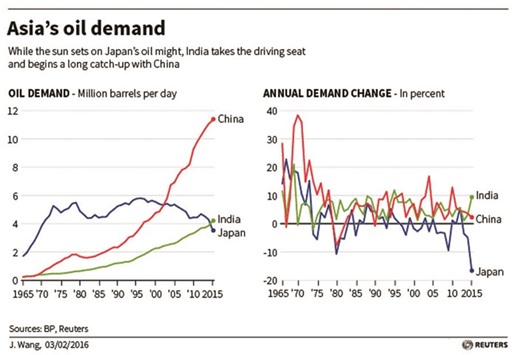Asia’s oil markets are being upended as India’s and China’s refiners overtake once-dominant buyers like Japan and challenge the US as the world’s biggest consumer.
The shifts are not only establishing new trade routes but are also challenging the way oil is priced in the region as the new players push for more cash cargoes and fewer long-term deals.
China and India’s combined share of world oil consumption has tripled since 1990 to over 16%, nearing the US share of roughly 20%, cementing their status as the main centre of global demand growth.
“Asian oil markets are in a tremendous period of flux,” said Owain Johnson, managing director of Dubai Mercantile Exchange (DME).
By 2040, China and India could double their share again to a third, analysts say.
One of Asia’s rising traders is Indian Oil Corp, which operates 11 refineries with a combined capacity of 80.7mn tonnes a year (1.9mn barrels per day), a third of India’s capacity and roughly the same size as Exxon’s US refining base.
“Spot crude (trading) gives more flexibility and more variety is available. Last year we raised spot purchases and for this year we are working out a strategy,” said its head of finance AK Sharma.
The changes come at the expense of western majors, with Shell complaining in December that aggressive trading, conducted by Chinese companies, meant Asian crude prices didn’t properly reflect the market.
“Chinese oil companies have become the new power houses in oil trading,” said Oystein Berentsen, managing director of crude at Strong Petroleum in Singapore.
Previously, Asia’s largest oil buyers from Japan – which once accounted for about 10% of global demand – stuck with long-term contracts.
Now, as China and India take the lead, a growing share of trading is done on a spot basis as buyers prioritise cost and delivery flexibility over fixed shipment schedules.
Moreover, thanks to the hefty volumes, the new buyers are able to extract favourable prices. China and India’s combined daily net crude imports exceed 10mn barrels, or some 3mn bpd more than top importer the US.
The new buyers are also bringing new characteristics to the marketplace.
“Indians are more flexible than many of their Asian peers, buying up distressed or stranded cargoes when
there’s a profitable opportunity,” said Ivan Szpakowski, head of Asia commodity research at Citigroup.
“India will become the biggest source of oil consumption growth. Its geography also changes trade flows. If you look at a map, the Middle East is much closer to India than to Japan or China and such shipments are effectively short-haul.”
In China, state-owned oil giants have been joined by nearly 20 independent refiners which have been granted import licenses and exclusively buy spot supplies.
Their arrival is changing trade flows through their preference for cheaply-delivered Russian crudes which has helped Russia challenge the Middle East as China’s biggest supplier.
Not all is smooth sailing. Richard Gorry, director of JBC Energy Asia, said the rise of these traders is causing “teething problems” as they make their first deals with highly regulated international companies.
In January, a crude cargo sold to an independent Chinese refiner by western merchants Vitol and Mercuria had to be resold after the firm failed to secure financing, while this month another private Chinese company walked away from a deal to buy $680mn of Russian oil, citing “changes in the market” as a reason.
China’s national oil firms are also challenging Asia’s leading price benchmark, the Dubai Market-on-Close (MoC) by Platts, used to price more than 12mn bpd of crude to Asia, by frequently sweeping up almost all available cargoes, preventing other traders from participating in the pricing process. To avoid further squeezes, Platts made more crude available in its MoC, and Dave Ernsberger, head of global oil content at Platts, a subsidiary of McGraw Hill Financial, said it “absolutely makes sense” for China to take “a much more pre-eminent role in price discovery.”
Still, challengers are circling.
“The old system is no more and the creation of new systems and patterns of behaviours has begun,” said Jorge Montepeque, who set up the MoC system for Platts in the 1990s and is now an independent consultant.
Keen to play a bigger part in price creation, China plans to launch Shanghai crude futures.
Other exchanges are also looking to capitalise on the change.
“China is obviously keen to have an ever greater say in pricing. At the same time, Iran is returning to the market. Firms across Asia are looking at new ways of doing business and legacy arrangements are all under review,” DME’s Johnson said.

..


